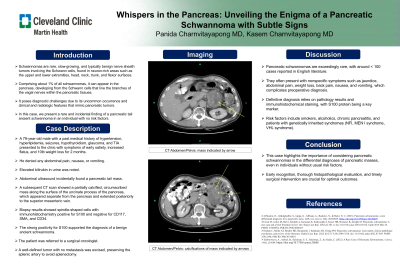Sunday Poster Session
Category: Biliary/Pancreas
P0169 - Whispers in the Pancreas: Unveiling the Enigma of a Pancreatic Schwannoma With Subtle Signs
Sunday, October 27, 2024
3:30 PM - 7:00 PM ET
Location: Exhibit Hall E

Has Audio

Panida Charnvitayapong, MD
University of Miami Miller School of Medicine at JFK Medical Center
Lantana, FL
Presenting Author(s)
Panida Charnvitayapong, MD1, Kasem Charnvitayapong, MD2
1University of Miami Miller School of Medicine at JFK Medical Center, Lantana, FL; 2Cleveland Clinic Martin Health, Palm City, FL
Introduction: Schwannomas are rare, slow-growing, and typically benign nerve sheath tumors involving the Schwann cells, found in neuron-rich areas such as the upper and lower extremities, head, neck, trunk, and flexor surfaces. Comprising about 1% of all schwannomas, it can appear in the pancreas, developing from the Schwann cells that line the branches of the vagal nerves within the pancreatic tissues. It poses diagnostic challenges due to its uncommon occurrence and clinical and radiologic features that mimic pancreatic tumors. In this case, we present a rare and incidental finding of a pancreatic tail ancient schwannoma in an individual with no risk factors.
Case Description/Methods: A 79-year-old male with a past medical history of hypertension, hyperlipidemia, seizures, hypothyroidism, glaucoma, seizures, and TIA presented to the clinic with symptoms of early satiety, increased flatus, and 10lb weight loss for 2 months. He denied any abdominal pain, nausea, or vomiting. Elevated bilirubin in urine was noted. Abdominal ultrasound incidentally found a pancreatic tail mass. A subsequent CT scan showed a partially calcified, circumscribed mass along the surface of the uncinate process of the pancreas, which appeared separate from the pancreas and extended posteriorly to the superior mesenteric vein. Biopsy results showed spindle-shaped cells with immunohistochemistry positive for S100 and negative for CD117, SMA, and CD34. The strong positivity for S100 supported the diagnosis of a benign ancient schwannoma.
The patient was referred to a surgical oncologist. A well-defined tumor with no metastasis was excised, preserving the splenic artery to avoid splenectomy.
Discussion: Pancreatic schwannomas are exceedingly rare, with around < 100 cases reported in English literature. They often present with nonspecific symptoms such as jaundice, abdominal pain, weight loss, back pain, nausea, and vomiting, which complicates preoperative diagnosis. Definitive diagnosis relies on pathology results and immunohistochemical staining, with S100 protein being a key marker. Risk factors include smokers, alcoholics, chronic pancreatitis, and patients with genetically inherited syndromes (NFI, MEN I syndrome, VHL syndrome).
This case highlights the importance of considering pancreatic schwannomas in the differential diagnoses of pancreatic masses, even in individuals without usual risk factors. Early recognition, thorough histopathological evaluation, and timely surgical intervention are crucial for optimal outcomes.
Disclosures:
Panida Charnvitayapong, MD1, Kasem Charnvitayapong, MD2. P0169 - Whispers in the Pancreas: Unveiling the Enigma of a Pancreatic Schwannoma With Subtle Signs, ACG 2024 Annual Scientific Meeting Abstracts. Philadelphia, PA: American College of Gastroenterology.
1University of Miami Miller School of Medicine at JFK Medical Center, Lantana, FL; 2Cleveland Clinic Martin Health, Palm City, FL
Introduction: Schwannomas are rare, slow-growing, and typically benign nerve sheath tumors involving the Schwann cells, found in neuron-rich areas such as the upper and lower extremities, head, neck, trunk, and flexor surfaces. Comprising about 1% of all schwannomas, it can appear in the pancreas, developing from the Schwann cells that line the branches of the vagal nerves within the pancreatic tissues. It poses diagnostic challenges due to its uncommon occurrence and clinical and radiologic features that mimic pancreatic tumors. In this case, we present a rare and incidental finding of a pancreatic tail ancient schwannoma in an individual with no risk factors.
Case Description/Methods: A 79-year-old male with a past medical history of hypertension, hyperlipidemia, seizures, hypothyroidism, glaucoma, seizures, and TIA presented to the clinic with symptoms of early satiety, increased flatus, and 10lb weight loss for 2 months. He denied any abdominal pain, nausea, or vomiting. Elevated bilirubin in urine was noted. Abdominal ultrasound incidentally found a pancreatic tail mass. A subsequent CT scan showed a partially calcified, circumscribed mass along the surface of the uncinate process of the pancreas, which appeared separate from the pancreas and extended posteriorly to the superior mesenteric vein. Biopsy results showed spindle-shaped cells with immunohistochemistry positive for S100 and negative for CD117, SMA, and CD34. The strong positivity for S100 supported the diagnosis of a benign ancient schwannoma.
The patient was referred to a surgical oncologist. A well-defined tumor with no metastasis was excised, preserving the splenic artery to avoid splenectomy.
Discussion: Pancreatic schwannomas are exceedingly rare, with around < 100 cases reported in English literature. They often present with nonspecific symptoms such as jaundice, abdominal pain, weight loss, back pain, nausea, and vomiting, which complicates preoperative diagnosis. Definitive diagnosis relies on pathology results and immunohistochemical staining, with S100 protein being a key marker. Risk factors include smokers, alcoholics, chronic pancreatitis, and patients with genetically inherited syndromes (NFI, MEN I syndrome, VHL syndrome).
This case highlights the importance of considering pancreatic schwannomas in the differential diagnoses of pancreatic masses, even in individuals without usual risk factors. Early recognition, thorough histopathological evaluation, and timely surgical intervention are crucial for optimal outcomes.
Disclosures:
Panida Charnvitayapong indicated no relevant financial relationships.
Kasem Charnvitayapong indicated no relevant financial relationships.
Panida Charnvitayapong, MD1, Kasem Charnvitayapong, MD2. P0169 - Whispers in the Pancreas: Unveiling the Enigma of a Pancreatic Schwannoma With Subtle Signs, ACG 2024 Annual Scientific Meeting Abstracts. Philadelphia, PA: American College of Gastroenterology.
